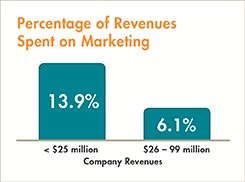Setting Your Marketing Budget: A 2-Part Process
There are more than a few yardsticks that can be used in setting your marketing budget. But, the real trick to selling it to the C Suite lies in making that spending accountable.

Setting and Getting Your Marketing Budget Calls for Accountability
Follow the Money!
By Mark Semmelmayer
Chief Idea Officer
Pen & Inc. Marketing Communications
As marketers, we know there are three certainties in life. Death, taxes and the annual struggle to set and sell next year’s marketing budget to management. But, what if there’s a way to make the process less angst-ridden and the budget more acceptable in the C Suite? Well, I believe there is.
Setting your annual budget should be a 2-part process. First, you need to establish a realistic spending level, based on expectations of the part marketing will play in sales and revenue. Second, you need to create a model of the revenue attributable to sales and marketing activities that nurture and achieve the sale. In this fashion, you tie spending to revenue, an equation that the CEO and CMO can quickly grasp and, hopefully, embrace.
Setting Your Budget: Some Traditional Models and Considerations
According to the WSJ, manufacturing spends 8% of revenue in advertising/marketing http://deloitte.wsj.com/cmo/2017/01/24/who-has-the-biggest-marketing-budgets/. That's an average. Perhaps a better way to benchmark B2b spend is by company's total revenue. Forrester and CMO both did studies on B2B spending over the last few years and you can see a recap here: http://www.industrialmarketer.com/big-b2b-marketing-budget/. As you can see in the story, companies under $25MM spend at over twice the rate of companies with >$25MM revenues, about 13% of revenue vs. about 6%.

Other, more specific approaches to establishing your budget can be found at Chicago-based Artillery Marketing’s website. This link is to a blog on ways to develop a marketing budget based on percentage of sales and/or a variety of other, numbers-based markers:
https://www.artillerymarketing.com/blog/bid/194348/How-Much-Should-You-Be-Spending-On-B2B-Marketing
These all provide "on average" information. But, as a proponent of Integrated Marketing Communications (IMC), I think the one size doesn’t fit all in marketing spend. Some factors to consider:
- How competitive is your environment? Do competitors outspend you and gain share?
- Do customers view you as a strong brand. As Gardner’s Media Usage study showed, brand is factor #1 in B2B buyer decisions. To be a "go to", you need to build the brand, and that requires spending.
- What kind of metrics do you have to show which marketing elements work and which don’t? IMC is about what the customer wants, not what you're selling. You must make sure branded messages reach them how, when and where they want them, and prove they react.
- What are you doing to build a digital marketing infrastructure for the future? Today, key B2B buyers are aging and retiring. Younger buyers use more digital resources . . . search, social, websites and industry blogs . . . than traditional marketing channels.
Selling Your Budget: Detailing Revenue Attribution
My first exposure to tying revenue to marketing came in the mid ‘90s, via a colleague on the BMA National Board, a marketing director for a software company which launched a new product the previous year. Before launch, she arranged to add every inquiry entered into the company’s invoice database. At year’s end, she matched invoices to inquirers and tracked nearly $3MM to marketing. Rudimentary, but remember, this was pre-marketing automation.
She set a budget for the following year and submitted it. For the budget meeting, she ginned up a PowerPoint and presented it. The Exec Committee turned her down and, in fact, cut the previous year’s budget in half. Her PowerPoint still up, she scrolled back to the slide showing the $3MM revenue gain and said, “If that’s the way it’s going to be, will someone please tell me which million and a half in sales you don’t want.”
Later that day, her boss came into her office, sat on the corner of her desk and told her the budget was approved, “but it better darn well work like last year’s.”
Creating a Revenue Attribution Model
I’m an ad guy who broke into agencies on the creative side, moving to account and marketing management before the advent of glitzy analytics and automation. My budgets were always accountable, but today, analytic data is enabling better ways to model and project revenue tied to sales and marketing. Building that model alongside your marketing plan/budget makes the process more seamless . . . and easier to sell in the C Suite.

Not being an expert on the process, to close this article out I’m going to rely on 2 blogs posted on SBI Magazine’s website by Mike Spence and Aaron Bartels, who provide a better picture of it.
In his August ‘17 blog, “Building a Believable Revenue Attribution Model”, Spence sees revenue attribution as a key to “stay in the CEO’s good graces” In the blog, Spence states: “Revenue attribution begins with the end in mind. Value creation in financial terms balances revenue and cost.
The model needn’t be overly complex. It’s designed to put the impact of marketing spend on revenue into terms the organization can understand. Don’t make it too technical or deep on analytics. “Create a revenue attribution model that tracks each dollar of revenue back to the marketing and sales activities that sourced, converted, nurtured, and propelled opportunities.”
Revenue Attribution May Get You a Seat at the C Suite Table
The other author mentioned earlier, Aaron Bartels, wrote a blog for SBI in June of ‘17, “What Revenue Attribution Can Do for the Board”. In it, he suggests a viable accounting of ROI from sales and marketing activities “often leads to a shift in budget allocations — and more value creation from the associated revenue growth.”
Because over half of a customer’s buying journey is likely complete before they ever make contact with a seller, “marketing programs must move buyers along to that point.” The purpose of revenue attribution modeling is to detail the value created by the capture of new revenue.
He sees the real value in the C Suite. “An astute board understands the importance of revenue attribution and the associated value creation. It supports the CMO, knowing that revenue attribution is a directionally correct discussion.”
SBI has published a special supplement devoted to revenue attribution. You can download it here.
Need more information?
Mark Semmelmayer
Chief Idea Officer
Pen & Inc. Marketing Communications
Marietta, GA
770-354-4737
LinkedIn

RELATED CONTENT
-
26 Relevant Print Marketing Statistics: 2022 Ad Spending & Impact
Print marketing is not dead. Its impact on consumer brand recall and purchase decision is worth considering, especially if you want to implement an integrated, multi-channel approach to your marketing strategy. This article on marketing trends and predictions can provide more insights on strategies you can use for your business or marketing clients.
-
"Made in the USA" Podcast: Show for This Moment in U.S. Manufacturing
“Made in the USA,” is a six-part documentary-style podcast series that strives to uncover the hidden history of how manufacturing in the United States arrived at its current state and lays out where it can go from here.
-
How to Write a B2B Marketing Email That Works
B2B copywriter David McGuire shares four tips to help stand out in a crowded inbox. He tries to stick to these four key principles when writing emails.

